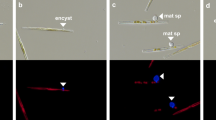Abstract
Epidemic chytrid fungal infection of Peridinium gatunense, the major bloom-forming dinoflagellate in Lake Kinneret, Israel, is reported for the first time. The fungus, identified as Phlyctochytrium sp. based on morphological and life cycle characteristics, was first observed in December 2000. It rapidly developed into an epidemic, coinciding with a 1000-fold decline in Peridinium density within 9 days of the initial observation of the chytrid. In August 2001 a second fungal epidemic occurred, which was again associated with a Peridinium population crash. In 2002–2003 less dramatic fungal epidemics were recorded, infection prevalence was low and the Peridinium population did not crash. Laboratory experiments demonstrated that healthy Peridinium cells are not prone to fungal infection, mostly stressed or dead cells were infected. In other words, Phlyctochytrium is a saprophyte, possibly a facultative parasite of Peridinium. Probably another pathogen was responsible for the observed bloom crashes and the saprophytic Phlyctochytrium was a secondary parasite, infecting the already moribund cells. The emergence of fungal epidemics in Lake Kinneret could be interpreted as an early signal of ecosystem response to increasing anthropogenic stress.
Similar content being viewed by others
References
T. Berman Y. Z. Yacobi U. Pollingher (1992) ArticleTitleLake Kinneret phytoplankton: stability and variability during twenty years (1970–1989) Aquatic Sciences 54 104–127 Occurrence Handle10.1007/BF00880278
T. Berman L. Stone Y. Z. Yacobi B. Kaplan M. Schlichter A. Nishri U. Pollingher (1995) ArticleTitlePrimary production and phytoplankton in Lake Kinneret: a long-term record (1972–1993) Limnology and Oceanography 40 1064–1076 Occurrence Handle1:CAS:528:DyaK2MXpsVCrtbs%3D
T. Berman U. Pollingher T. Zohary (1998) ArticleTitleA short history of stability and change in phytoplankton populations in Lake Kinneret Israel Journal of Plant Sciences 46 73–80
H. M. Canter (1961) ArticleTitleStudies on British Chytrids XVIII. Further observations of species invading planktonic algae Nova Hedwiga 3 73–82
O. Hadas R. Pinkas E. Delphine A. Vardi A. Kaplan A. Sukenik (1999) ArticleTitleLimnological and ecophysiological aspects of Aphanizomenon ovalisporum bloom in Lake Kinneret, Israel Journal of Plankton Research 21 1439–1453 Occurrence Handle10.1093/plankt/21.8.1439
K. D. Hambright T. Zohary W. Eckert (1997) ArticleTitlePotential influence of low water levels on Lake Kinneret: re-appraisal and modification of an early hypothesis Limnologica 27 149–155 Occurrence Handle1:CAS:528:DyaK2sXmtFCmt74%3D
Hambright, K. D. & T. Zohary, 1999. The Hula Valley (Northern Israel) Wetlands Rehabilitation Project. In Streever, W (ed.), International perspectives in wetlands rehabilitation. Kluwer Academic Press, p. 173–180.
C. T. Ingold (1944) ArticleTitleStudies of British chytrids. II. New chytrids on Ceratium and Peridinium Transactions of British Mycological Society 27 93–96 Occurrence Handle10.1016/S0007-1536(44)80015-8
M. Kagami A. Bruin Particlede B. W. Ibelings E. Donk ParticleVan (2007) ArticleTitleParasitic chytrids: their effects on phytoplankton communities and food-web dynamics Hydrobiologia 578 113–129
M. Kagami J. Urabe (2002) ArticleTitleMortality of the planktonic desmid, Staurastrum dorsidentiferum, due to interplay of fungal parasitism and low light conditions International Journal of Theoretical and Applied Limnology 28 1001–1005
K. Lindstrom (1984) ArticleTitleEfect of temperature, light and pH on growth, photosynthesis and respiration of the dinoflagellate Peridinium cinctum fa westii in laboratory cultures Journal of Phycology 20 212–220 Occurrence Handle10.1111/j.0022-3646.1984.00212.x
R. A. Paterson (1960) ArticleTitleInfestation of Chytridiaceous fungi on phytoplankton in relation to certain environmental factors Ecology 41 416–424 Occurrence Handle10.2307/1933316
U. Pollingher (1981) ArticleTitleThe structure and dynamic of the phytoplankton assemblages in Lake Kinneret, Israel Journal of Plankton Research 3 93–105 Occurrence Handle10.1093/plankt/3.1.93 Occurrence Handle1:CAS:528:DyaL3MXkt1Wmsrg%3D
U. Pollingher (1986) ArticleTitlePhytoplankton periodicity in a subtropical lake (Lake Kinneret, Israel) Hydrobiologia 138 127–138 Occurrence Handle10.1007/BF00027236
Pollingher, U., 1988. Freshwater armored dinoflagellates: growth, reproductive strategies and population dynamics. In Sandgren, C. (ed.), Growth and Reproduction Strategies of Freshwater Phytoplankton Cambridge University Press, 134–174.
Reynolds, C. S., 2002. On the interannual variability in phytoplankton production in freshwaters. In Williams, P. J. B. (ed.), Phytoplankton productivity: Carbon assimilation in marine and freshwater ecosystems Blackwell Science, 187–221.
D. W. Schindler (1987) ArticleTitleDetecting ecosystem responses to anthropogenic stress Canadian Journal of Fisheries and Aquatic Scienes 44 6–25 Occurrence Handle1:CAS:528:DyaL1cXhtVOntLw%3D Occurrence Handle10.1139/f87-276
Sommer, U., C. Wedemeyer & B. Lowsky, 1984. Comparison of potential growth, B 1983. Dinoflagellate resting cysts: “bentic plankton”. In Fryxell, G. A. (ed.) Survival strategies of the algae Cambridge, 69–136.
H. Utermohl (1958) ArticleTitleZur Vervollkommnung der quantitativen phytoplankton methodik. Phytoplankton-Methodik Mitteilungen Internationale Vereinigung Theoretische und Angewandte Limnologie 9 1–38
A. Vardi I. Berman-Frank T. Rozenberg O. Hadas A. Kaplan A. Levine (1999) ArticleTitleProgrammed cell death of the dinoflagellate Peridinium gatunense is mediated by CO2 limitation and oxidative stress Current Biology 9 1061–1064 Occurrence Handle10508616 Occurrence Handle10.1016/S0960-9822(99)80459-X Occurrence Handle1:CAS:528:DyaK1MXmtlagsLs%3D
T. Zohary H. Gude B. Kaplan R. Pinkas O. Hadas (2000) ArticleTitleThe effect of nutrients (N, P) on the decomposition of Peridinium gatunense cells and thecae Limnology and Oceanography 45 123–130 Occurrence Handle1:CAS:528:DC%2BD3cXpt1ertw%3D%3D Occurrence Handle10.4319/lo.2000.45.1.0123
T. Zohary (2004) ArticleTitleChanges to the phytoplankton assemblage of Lake Kinneret after decades of a predictable, repetitive pattern Freshwater Biology 49 1355–1371 Occurrence Handle10.1111/j.1365-2427.2004.01271.x
Author information
Authors and Affiliations
Corresponding author
Rights and permissions
About this article
Cite this article
Alster, A., Zohary, T. Interactions between the bloom-forming dinoflagellate Peridinium gatunense and the chytrid fungus Phlyctochytrium sp.. Hydrobiologia 578, 131–139 (2007). https://doi.org/10.1007/s10750-006-0439-y
Issue Date:
DOI: https://doi.org/10.1007/s10750-006-0439-y




